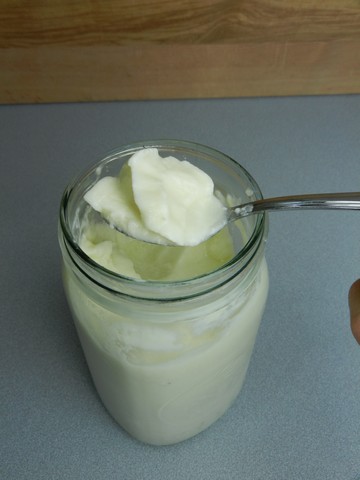
Homemade, plain yogurt is easy enough to make. But how do you make sweetened vanilla yogurt without turning it into a runny mess? In this post, I will show you how to make thick and creamy, wonderful homemade vanilla yogurt using a cooler as an incubator, and of course I will share the recipe as well. If you do try this recipe, I would really appreciate a quick comment with a star rating (option found immediately under each recipe). It helps me out tremendously! Thanks in advance!
Is yogurt good for you, I mean, really?
Yogurt is good and good for you, isn’t that what we’ve leaned? Looking at the ingredients list at the grocery store, one can begin to wonder if this is really true after all. What had me wonder was the high sugar content, “other” ingredients, and live cultures, or rather, the lack thereof. As I’ve read about it and looked more closely at ingredients lists, I have found that store bought yogurt often contains loads of sugar, artificial colors and flavorings, and not all of them contain live cultures. Sure, the culture is alive when it first starts out, but not necessarily by the time the yogurt ends up at the store. According to an article by Dr. Weil, MD, yogurt is sometimes heat treated after the fact to increase shelf life, which kills the precious living bacteria that we need. “Made with” doesn’t mean “still alive”. Look for “active” or “living” cultures. OR: simply make it at home!! It’s easy, cheap, absolutely delicious, and you decide what goes into it. Even though I do believe plain is better for you, personally I love sweetened vanilla yogurt. I have found that it doesn’t take near the amount of sugar to satisfy me as what I’ll find in a container from the store. I’m OK with adding a little sugar at home.
Do you need to purchase an incubator for culturing?
Absolutely not! There are many ways of culturing without the use of yet another machine (incubator) to take up room in your kitchen. Personally I have used my cooler with great success!
The Recipe
You also need a great recipe, which I will provide for you with the help of two lovely ladies who not only gave me permission to use their recipe, but also took the time to go through a lot of details in how to make sweetened vanilla yogurt. I’ll be forever grateful for all of your help and advice, thank you so much, Joyce Vogel and Martha Artyomenko!
Plain yogurt is easy to make, using a tiny bit of yogurt containing live, beneficial bacteria as a culture. Sweetened yogurt is harder to make, but this recipe helps you make sweet vanilla yogurt that keeps its shape and doesn’t end up a runny mess. Adding pectin powder is one of the secrets!
The Process
I like to make a gallon at a time, because it tastes so good that we go through it pretty quickly. This recipe can easily be halved as well.
I start out by pouring a gallon of whole milk into a big pot with a heavy bottom. (You might be able to use low fat milk as well, but it is said that whole milk will produce a thicker, creamier yogurt.)
I heat the milk to 190° F, using a digital thermometer to guide me along. This is basically the point where the milk is really steaming, but definitely not boiling.
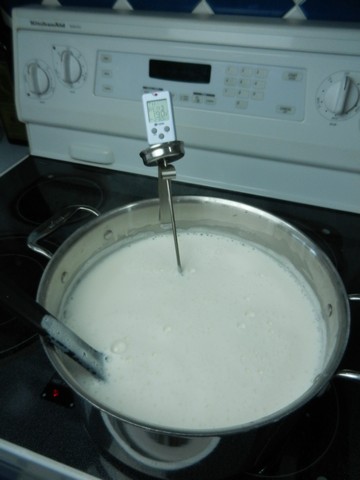
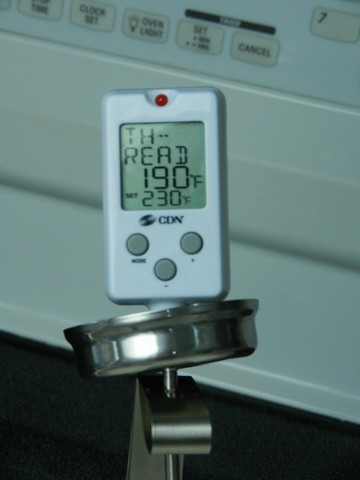
Then I let the milk cool to 130°, while I prepare other steps.
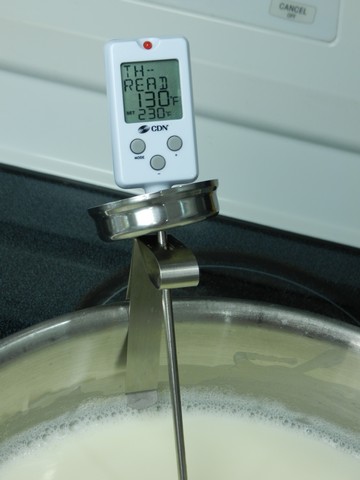
While I wait, I measure up sugar (reserving 2 Tbsp) and vanilla; I just pour the vanilla into the sugar to get rid of stuff from my counters.
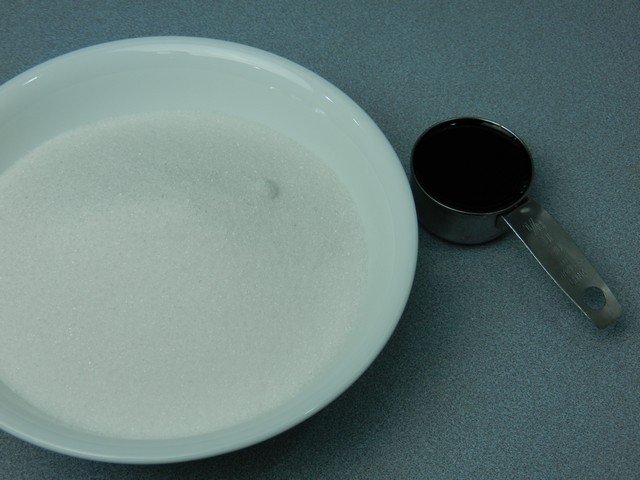
Then I whisk together the remaining 2 Tbsp of sugar along with 1 Tbsp pectin powder in a tiny pot. 2 Tbsp gelatin powder can be used in place for pectin powder, plain or flavored, though Mrs. Vogel and Mrs. Artyomenko recommends pectin as it gives the nicest texture.
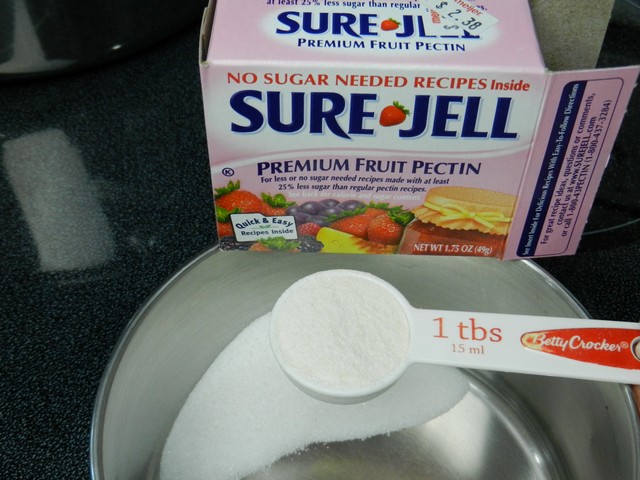
Without heating it yet, add 1/2 c cold water, whisking well until completely dissolved. I set this aside for now; I’ll heat it up later.
The type of whisk below is very commonly used in Europe and works very well, and it reaches nicely to the edge of bowls and pots. They can be found at Amazon and sometimes in specialty kitchen supply stores. I own three in different sizes and I use them all the time.
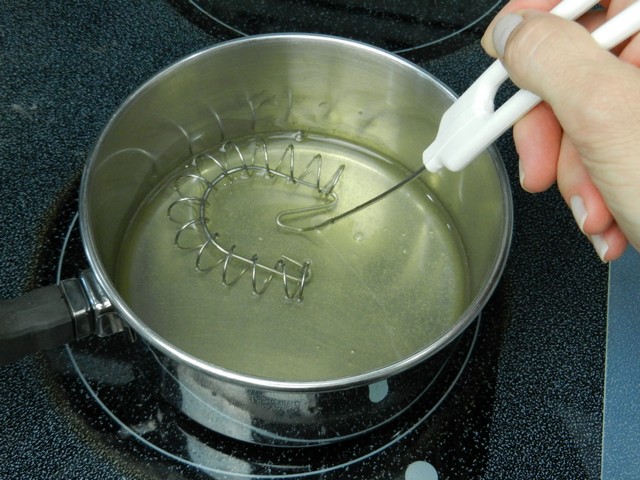
Next I measure 4 Tbsp (1/4 c) yogurt from the store that I’ll use for a starter. Your own yogurt can be used next time, but reading comments from people who have done this several times, it seems as if the effect only lasts a few times. Then they start having problems with their yogurt setting properly, until they use store bought yogurt again. So far I’ve only used starter from the store, I’ve never tried homemade yogurt as a starter.
This time I used plain yogurt. Flavored yogurt will work as well, as long as there are no berries or jam involved, also as long as the yogurt contains live and active cultures. I usually use a mixture of Dannon and Activa, because I like the idea of the combination of the types of bacteria used in these yogurts.
A word of caution: More starter is not better when it comes to culturing. Stick to the amounts given; if you add much more, it can cause problems with the culturing process.
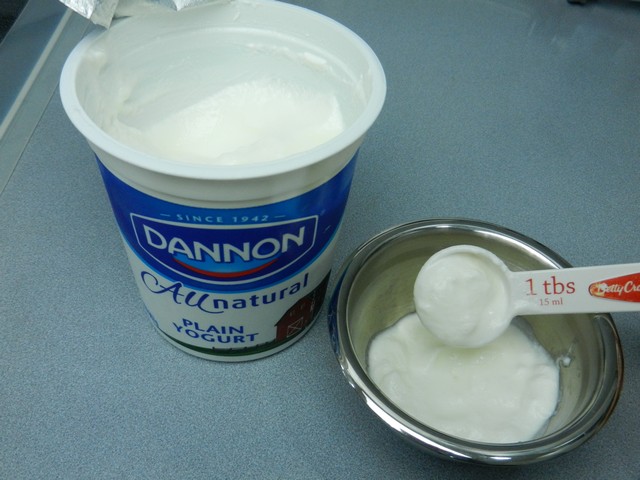
I’m still waiting for the milk to cool down, so I’ll gather the jars and the rest of the equipment: Large and small measuring cups (not necessary, but helpful), strainer, pot holder. I purchased plastic lids for my glass jars because I found that the metal rings rusted when placed in water for several hours. I’ve been very happy with these plastic lids, they work well and look pretty. I have found, though, that they need to be screwed on very tightly if the jars are inserted under water in the cooler. These are the lids I use: Ball Plastic Storage Caps and Wide Mouth Caps.
I prepare the jars ahead of time; measuring a gallons’ worth and figuring out how many jars I need. They need to be properly cleaned to avoid trouble with strange bacteria growth during the fermentation process.
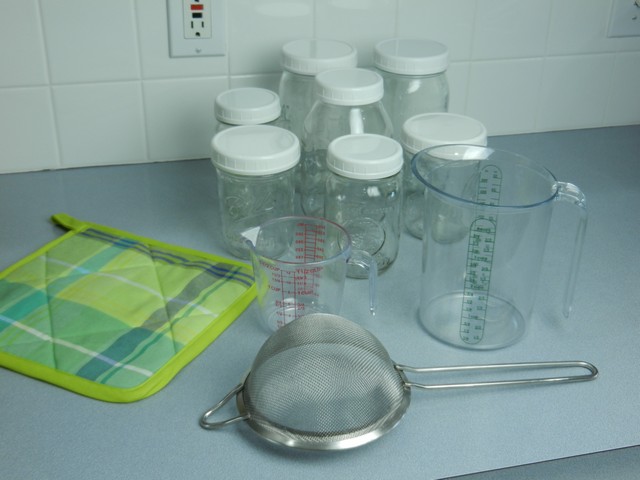
When the thermometer shows 130° F, the milk is very warm but no longer hot. According to Joyce Vogel and Martha Artyomenko, anywhere from 110-130° will do. It’s time to add some ingredients to get going on the yogurt making. This will be fun!

I add the sugar and vanilla…
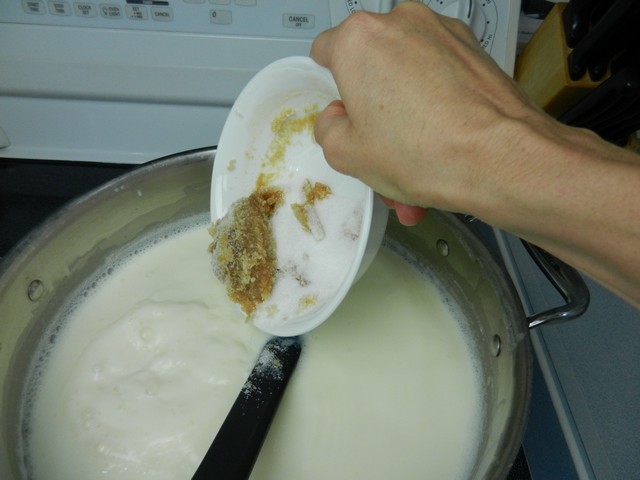
…and stir for two minutes. I have had some trouble in the past with grainy yogurt on the bottom of my jars, which is a rather unpleasant texture. I have found that stirring really well after adding various ingredients solved this problem. So, stir for two minutes.
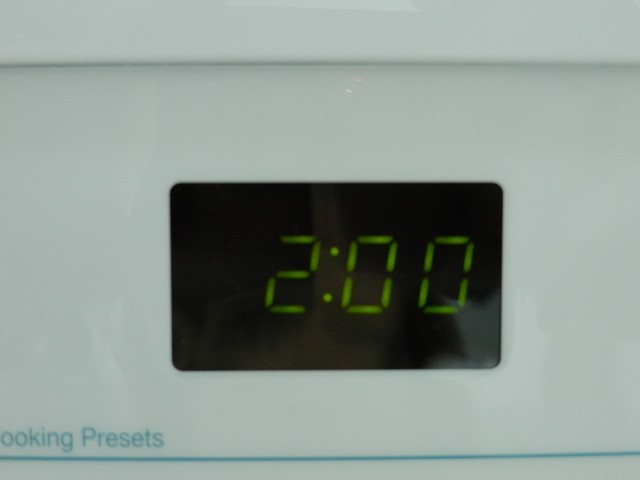
Now I heat up the little pot containing the pectin mix to a full rolling boil. Keep it boiling well for one minute.
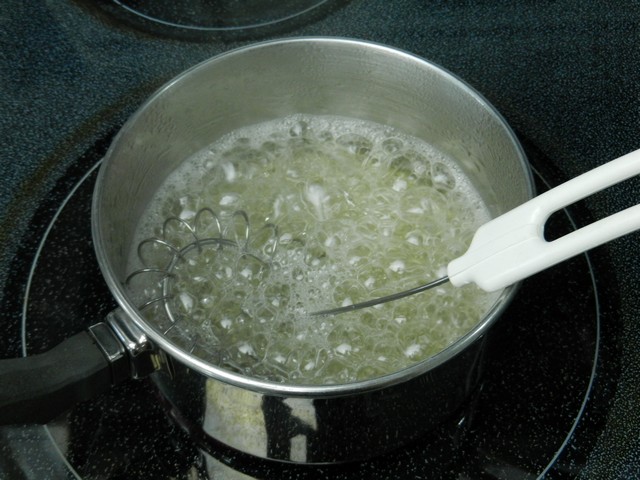
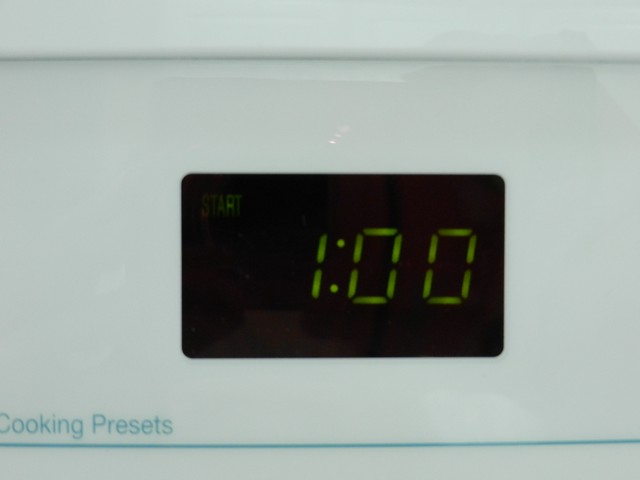
When the minute is up, I pour the pectin mixture into the milk in a thin stream while stirring the milk very well.
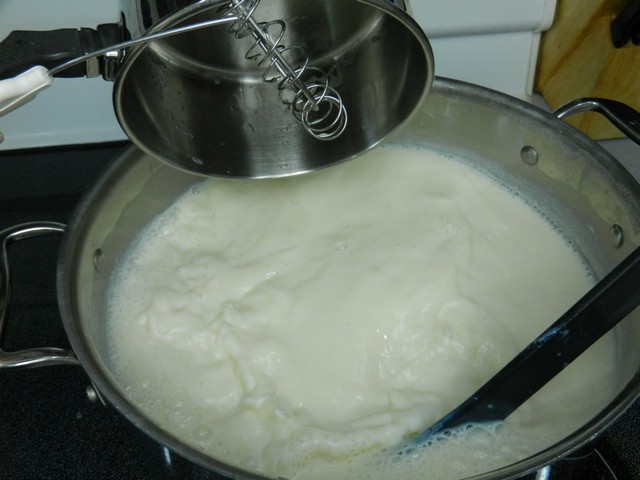
At this point I also add the yogurt starter, and stir well to blend it completely with the milk. It is very important to not add this culture before the milk has cooled down enough, otherwise the live bacteria will die and the culture will not work.
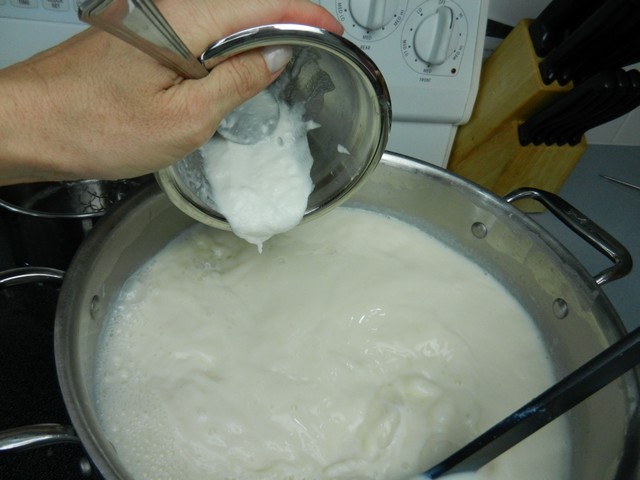
In fact, I start the timer again for two more minutes. I think this step is very important, in order to incorporate the pectin and yogurt completely.

Now the milk is ready to be poured into jars. One time, but only once, did I try to pour it directly from the pot. It didn’t go very well. I won’t share more details than that. After that I’ve been using a little measuring cup to get milk from the pot. Then, and this is another very important step, I pour the milk into a large measuring cup through a strainer. Even after all this stirring, I still find little lumps and grains of stuff in the strainer afterward, which probably comes from the pectin mix and likely accounts for the grainy consistency my yogurt had in the past.
You really could strain the milk directly into the jars, but I think it’s easier and faster if I use a large measuring cup.
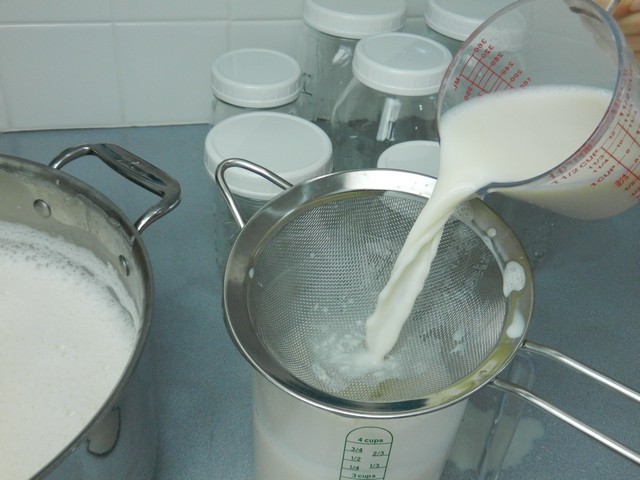
With a measuring cup, it’s an easy job to pour the milk into the jars. I pour up to 1/2 inch from the top of the jar. I don’t know if this is necessary or not, but it keeps my jars looking clean.
Up to here, then I stop:
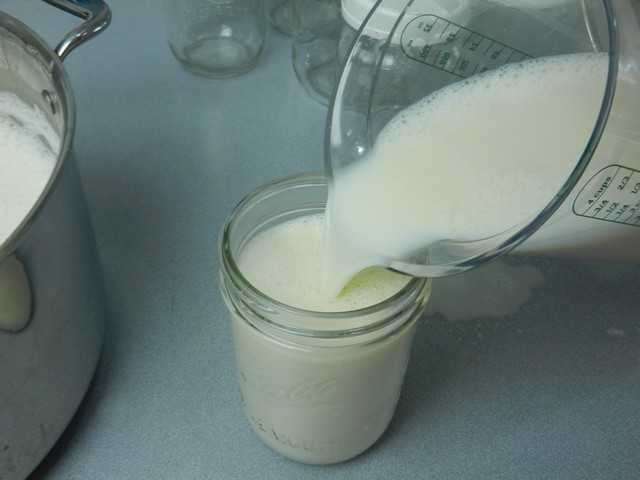
When all the jars are filled, I step back and admire my work. Wow! Look at that!
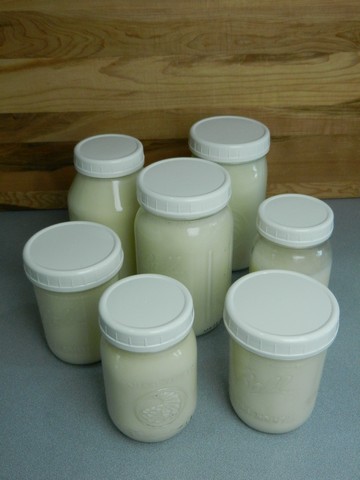
But I only take a few seconds to admire my jars, then I quickly put them into my large cooler. Because I worry about any drops of water from the cooler leaking into the jars, I try to keep the smaller ones at the same height as the larger jars. So I put other, empty containers on the bottom to give them a little shelf to sit on. This time I forgot what will happen once I add the water. The air inside the empty containers will cause my jars to tip, that’s what. So I had to reach into the very warm water to straighten things out after-the-fact. It isn’t hot-hot, but it feels hot enough when you stick your arms in there. Next time I’ll try to remember to place the small ones inside the cooler after a bit of the water is in there, to empty out the air from the “shelf”.
Just for your info, should you decide to get these nice plastic lids: When I tested them, I found that they would leak if they were not secured very tightly. After tightening more than usual, the jars wouldn’t leak, but little air bubbles came out from the sides of the lids when empty jars were placed under water, looking like water was entering. The insides of the jars stayed dry, so that must mean the air came from the sides of the lids, not from inside the jars. I still worry when I see the bubbles though, so I like my lids over the water’s edge.
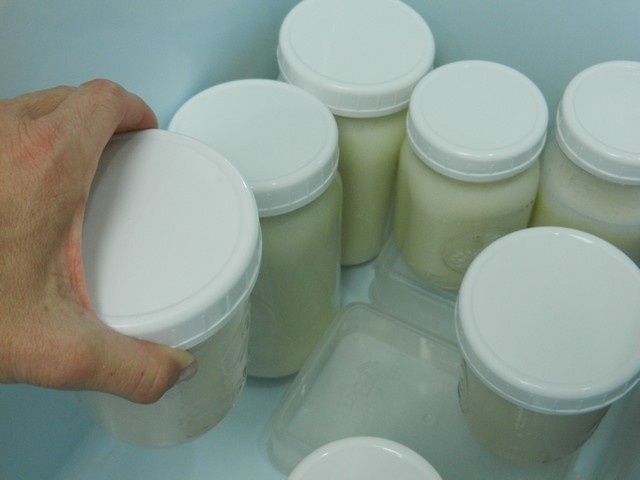
The water in the cooler should measure 130°; it can be a little bit cooler than that, but keep in mind that the water will probably cool down even more as it sits. So I like to start out with 130 degrees. The cooler will act as in insulator to keep the yogurt warm, which is necessary for the bacteria culture to multiply and grow. Just like you and I, bacteria thrive in warm temperatures; cold will make them sleepy and slow, while hot will kill them. The multiplying beneficial bacteria is what makes the yogurt, and this is why it is essential to keep the culture living. They can’t multiply if they’re dead, right?
I fill water up to the lids of the jars. I found that the hot water from my faucet, by the time it’s in the cooler, measures a little over 130°, so that’s been quite convenient for me. Even though a little bit over 130°, since the milk is in separate containers, it’s been OK.
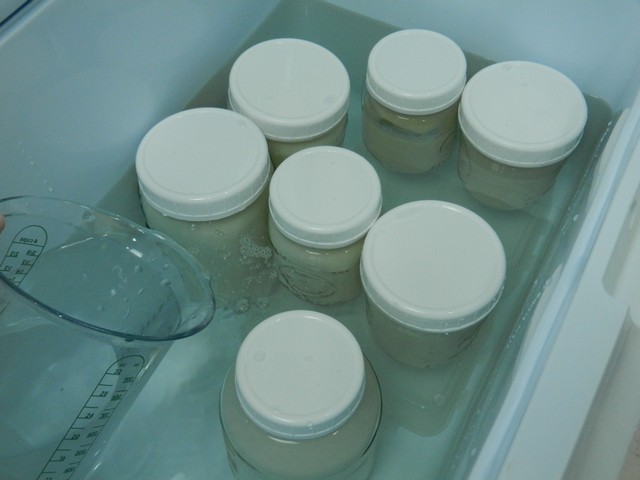
I close the lid, and let the jars sit for 6-8 hours. The longer the milk sits, the more tart the yogurt will be. The last time I made it, I actually forgot all about it; I made it early during the day and was going to take the jars out before I went to bed. Since I forgot, they were left to culture overnight, a total of 18 hours or so. I feared the worst, but it ended up just fine. The yogurt was a bit more tart than usual, but still very good.
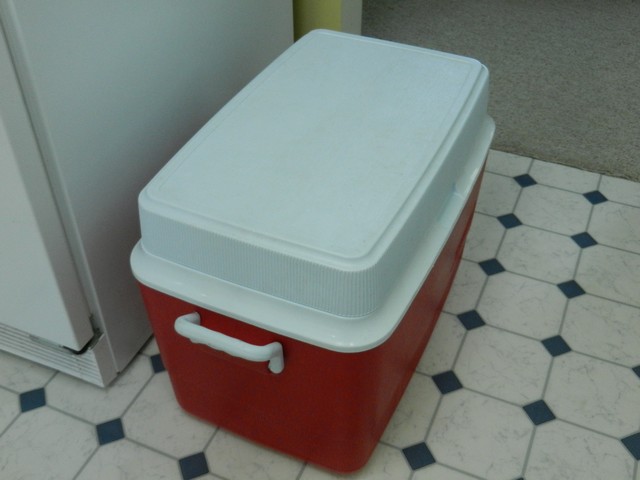
This yogurt is now done. Very nice and warm straight from the cooler. Since we use raw milk (very clean and from free range, well cared for, tested, and vaccinated cows), the top layer of the yogurt is milk fat that rises to the top. It looks a little funny, but it tastes nice and super creamy!

While still warm from the cooler, the yogurt is a bit soft and fragile, but will firm up more as it cools down. All jars are now placed in the refrigerator and used little by little.
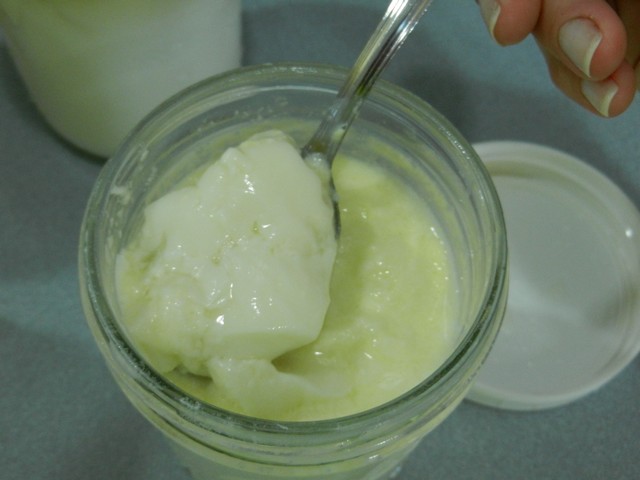
This yogurt has had the time to firm up in the refrigerator:
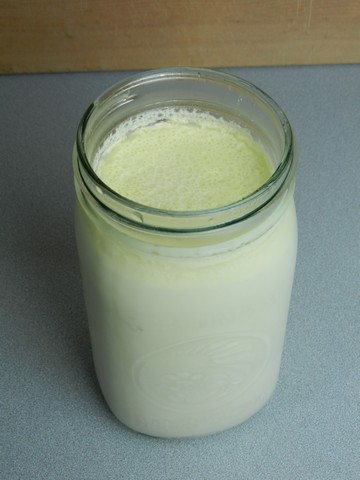
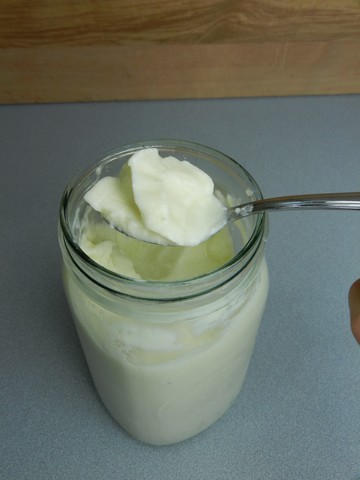
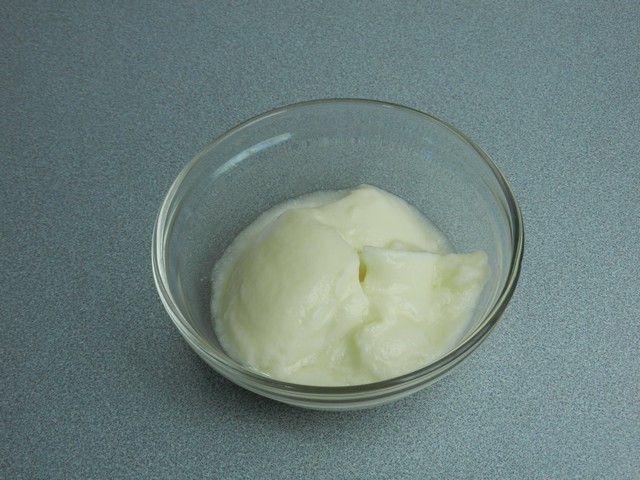
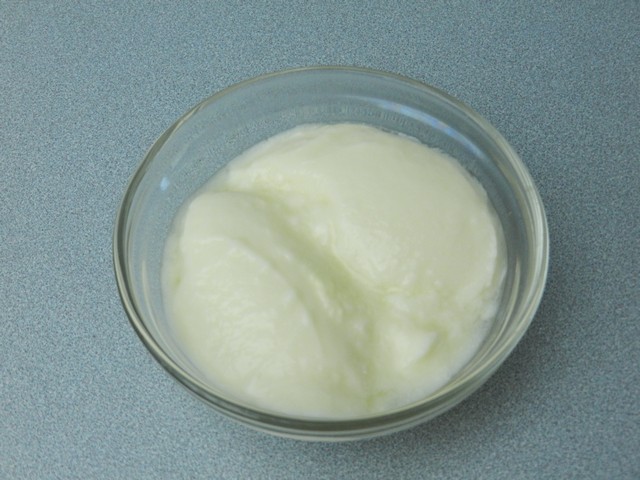
Ways to keep your yogurt culture warm
Other alternatives to keep yogurt warm for incubation:
*The oven, keeping the oven light on for warmth. My oven light doesn’t produce enough heat, so it wouldn’t work for me.
*Some people will pour the milk into a crock pot and keep it warm (unplugged) by covering with towels. The downside is that since with any yogurt, but especially homemade, whey will leak out whenever you stir or cut into it with a spoon, which is unavoidable when removing it from a crock pot into jars. So I prefer to keep it in jars from the beginning, to keep it nice and together and minimize leaking of whey. The whey is the watery stuff you’ll often see in yogurt. It is edible and you can stir it back in, but stirring does ruin the consistency somewhat.
*You can also purchase a yogurt maker, but I really don’t see the point if you already own a cooler. More money to spend, and more stuff to store. I will stick to my cooler.
It is wonderful to be able to easily make vanilla yogurt right at home, where I can control what goes into it. The following recipe helps me achieve that thick, smooth, creamy consistency that I love, adding some sweetness without an overload of sugar. And I love that I don’t have to purchase an incubator since I technically already have one: My good, faithful ol’ cooler! Please comment and rate this recipe if you try it; option is found immediately under the recipe. Thank you!!
- 1 gallon whole milk
- 1½ c sugar, divided
- 2 Tbsp vanilla extract
- 1 Tbsp pectin powder
- ½ c cold water
- ¼ c fresh Dannon yogurt, plain or vanilla (no jam)
- Heat milk in a heavy pot, to 190° F.
- Cool to 130° F (110-130° is OK)
- While milk is cooling, measure up sugar (reserving 2 Tbsp for later) and vanilla. Set aside.
- Mix together the remaining sugar, and pectin power in a small pot; whisk in cold water and mix well until dissolved. Set aside.
- In a small bowl, set aside the yogurt culture needed.
- When milk has reached 130° F, add sugar and vanilla, and stir for 2 minutes until dissolved.
- Bring the pot of pectin mixture to a full rolling boil. Keep boiling for 1 minute.
- In a thin stream, pour the pectin mixture into the milk, stirring well while pouring.
- Add yogurt. Keep stirring well for 2 more minutes.
- Pour into clean jars through a strainer.
- Place jars in a cooler, then pour very warm water into cooler (130°F) until it reaches the lids of the jars.
- Close the lid of the cooler, and keep the temperature at 110-130° for 6-8 hours, or until your preferred tartness has been reached.
- Place jars in refrigerator to cool down.
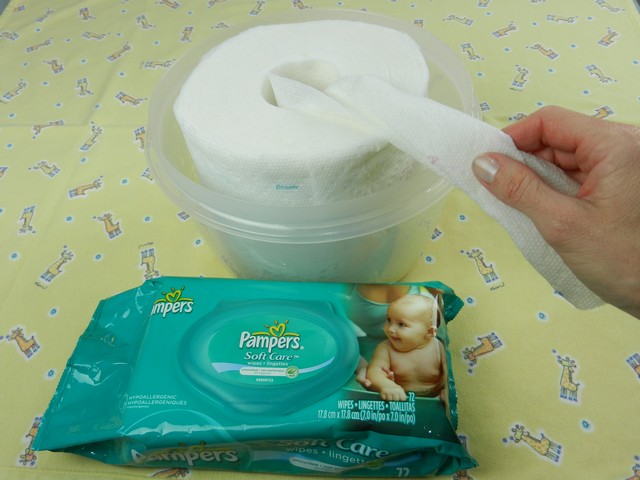

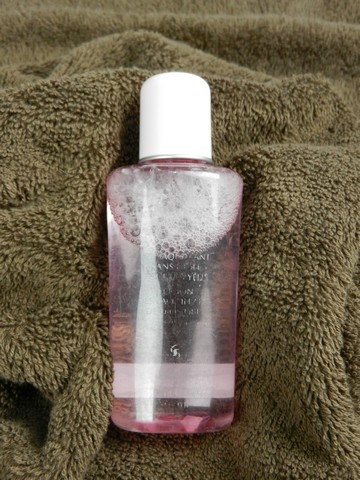
I just made this yogurt today and it is sooooo incredibly delicious!!!! Thank you so much!
I’m so happy to hear that!
Mine came out great too! I was able to skip a few steps because I used my MEC pure clay yogurt maker this way the pot can do a lot of the work for you. Its holds the heat for a long time helping in the fermentation process, because its a breathable pot it lets excess water evaporate thickening the yogurt naturally. I learned learned making yogurt in these pots from; https://miriamsearthencookware.com/2013/04/11/how-to-make-thick-delicious-yogurt/
I let it go for seven hours and it was perfectly done…I will definitely make this again and share this recipe, it’s too good not to and easy! Thanks again : )
You are very welcome! 🙂
Hi Terese i only want to make 1 litre of yoghurt as im the only one that eats it, can you tell me if i have converted it correctly.1 litre milk, 95g sugar, 2 tsp vanilla, 1 tsp pectin powder or 2 tsp gelatine, 32mls water, 1tbs frest yoghurt.also is jam set the same thing as pectin powder havnt seen pectin powder in Australia but im only new at this and havnt made it before but eager to try.Thanks. Vicki.
Hi Vicki,
Your measurements look pretty good to me. If you want the exact measurements, they are: just shy of 1 liter milk (950 ml), 85 grams sugar (6 Tbsp), 1 1 /2 tsp vanilla, 1 tsp pectin, 2 Tbsp water (30 ml), 1 Tbsp yogurt w/ active cultures.)
I don’t think your measurements are different enough to matter. I think you’ll be fine either way, so don’t worry too much about it. I don’t know what “jam set” is, but sounds like it may be the same thing or close. I would go ahead and try it, I don’t believe it will mess things up regardless (yogurt will set without it also, but not as well.) The only concern is whether you’ll be able to cook the pectin in such a small amount of water. Definitely use the very smallest pot you have to avoid evaporation, and even add a bit extra water just to avoid evaporation. Shouldn’t matter for the outcome. Hope all goes well!
Hi Terese,
I made the yoghurt on the weekend tasted good but very runny.Is there anything i can do now to thicken it. I did use the pectin powder.
I’m sorry you’re having some trouble. Several things can contribute to
runny yogurt or other problems. I’ll include a link to check out for
trouble shooting, which also gives you a recipe for how to fix runny
yogurt by adding gelatine. My initial thoughts are: Was the temperature
correct when you incubated? Too hot or too cold? And did you make sure
to use a starter that has live cultures in it, not just “made with” but
actually CONTAINS live cultures? And this culture must not be added to
milk of too high temperature, otherwise you’ll kill the bacteria. You
may even want to try to lower it to a bit less than 130 degrees next
time and see if that helps. Here’s that link: http://www.kitchenstewardship.com/2012/06/01/what-did-i-do-wrong-the-definitive-homemade-yogurt-troubleshooting-guide/
I put mine through paper coffee filters and it was thick like Greek yogurt!
That’s a good idea, Rose! I’ve heard of straining it to make Greek yogurt, but never tried it myself. Did it take a long time?
It was pretty time consuming so I went out and bought a few more strainers at the dollar store to make it go a bit faster 🙂
Terese, I wanted you to know that everyone who has tried your recipe says it’s the best yogurt they have ever had!!! I just love this recipe i’ve made it about three times now and it always turns out perfect!
That’s very nice to hear, thanks for letting me know! 😀
Awesome!!!! Thanks for letting me know that!
I’m sorry you’re having some trouble. Several things can contribute to runny yogurt or other problems. I’ll include a link to check out for trouble shooting, which also gives you a recipe for how to fix runny yogurt by adding gelatine. My initial thoughts are: Was the temperature correct when you incubated? Too hot or too cold? And did you make sure to use a starter that has live cultures in it, not just “made with” but actually CONTAINS live cultures? And this culture must not be added to milk of too high temperature, otherwise you’ll kill the bacteria. You may even want to try to lower it to a bit less than 130 degrees next time and see if that helps. Here’s that link: http://www.kitchenstewardship.com/2012/06/01/what-did-i-do-wrong-the-definitive-homemade-yogurt-troubleshooting-guide/
Here’s a helpful comment from Selin, who sent her comment to me via the contact form:
“Hi there, I just found your web site and read your post on making
yogurt.
I wanted to share a few things with you in yogurt making as I come from
the country where yogurt was invented, Turkey. In Turkey we did not
even have store bought yogurts only until very recently. Everyone I
know, knew makes their yogurt at home. I live in the US now but I make
my own at hone just as my grandma and mom taught me.
Because the milk is pasteurized, we boil the milk then cool down for
about 30 min, until it is lukewarm. We check it with our pinky as no
fancy gadgets were available at the time. You dip your pinky in the milk
, it is ready if it is warm but does not burn your finger. Then we add
the starter, for a gallon Id say about 5-6 TBS and stir, then close the
lid. Then we wrap the jar or the container you are using in 2-3 layers
of towels, blankets, whatever you have handy so they stay warm for 6
hours. Then we out them in the fridge (we dint open) they are ready by
morning. This is how we make it and yogurt is stiff, but if you want it
creamier and more stiff we use a cheesecloth to get rid of the access
water, then you get what we call suzme yogurt. And when I am low on
yogurt I always scoop enough amount to use as a starter aside and make
it again so I never use a store bought yogurt as a starter.
One more thing, if you live in a state that you can get goat milk the yogurt becomes even tastier. 🙂 “
Don’t know what happened. I followed the instructions, but when I started pouring into the strainer to fill the jars the pectin was staying in the strainer. It was jelled. Any ideas as to why this happened? I am incubating it in my dehydrator and hoping it will set anyway.
A small amount of pectin always stays in my strainer as well. It’s never affected the outcome, and normally yogurt sets without it as well, so it should be fine. The pectin helps to give it more reliable texture; the yogurt sets better and gets a little bit thicker from it, but a lot of yogurt recipes do not use pectin at all. I always make sure to stir well after adding it to the milk, but like I said, I always have little lumps of gelled pectin in my strainer, and that is precisely WHY I strain. 😉 Hope that makes sense and that your yogurt turns out great.
How long does the yogurt last? Like expiration date???
I think they generally say about 2 weeks.
Can you freeze the yogurt?
I believe you can, but I think freezing does affect the life span of the yogurt culture. Unfortunately I can not say for sure though, since I have not found good and reliable information on the life span of the culture and how different conditions affect these living micro organisms.
I make a gallon of yogurt at a time from my own goat’s milk. My husband puts 1/2 the batch in the freezer and it comes out fine. He eats it like ice cream. One thing I will suggest as an alternative. My husband is diabetic. I make my yogurt with no sugar or flavoring, just cultures. When it is done, I add 1 cup Splenda per 1 quart of yogurt. It makes the yogurt nice and sweet. You can put fruit in the bottom of the containers before you add yogurt and then refrigerate or freeze.
I believe you can, although it might alter the life span of the micro organisms, so it’s probably best if you don’t. It’s hard to find good information on these things, wish I could give you a better answer.
Can you stir in a little strawberry preserves just before you eat your serving? I want to try this so bad, but I’m not a fan of plain or vanilla yogurt. I have done this with plain store bought and its delicious..,just wondering
You can mix in anything you want right before serving. I will sometimes mix in newly mashed strawberries with a little sugar, which is SO yummy!! When making the yogurt, however, they do not recommend stirring in fruit before culturing. Also, if you stir the yogurt at all after it has set, it will start separating and will not hold its shape as well. So only stir up and mix whatever you will be eating right then.
I wonder why the fruit shouldn’t be stirred in before culturing? My boys do not like fruit pieces in their yogurt, so was hoping to cook fruits and strain for the juice to add in as I’m making it. Wonder how the manufacturers of store bought do it?
Yes, I wonder too! I think something happens to the consistency, but I’m not sure why. I too am curious what the difference is, why manufacturers are able to do it when we aren’t. Must be some of those hard-to-pronounce ingredients?
I put mine in the oven with the light on for 8 to 10 hours and it turns out great every time. One habit I have may aid in this though. I always store my cast iron skillets in the oven. So when I start the process of warming the milk, I turn my oven on to the lowest setting which is 170. When it reaches this level, I turn it off. It takes at least an hour for the milk to warm and then cool in the yogurt making process. Between the preheated cast iron and the oven light, the oven stays quite warm and the yogurt turns out fantastic.
Sounds like a great way to do it! Thanks for letting us know, it’s always nice to know about different options, to find what works the best for ourselves. Wonderful!
Gosh, what a simple recipe — and so few steps! I’ve been a fool all these years buying ready made yogurt at the store when all I needed to do was buy all the separate ingredients, take a day off of work, create a mess in my kitchen, use every dish and bowl in my pantry and then measure and stir and measure and stir and take the temperature and then check the temperature again and lastly check the temperature again — for 15 more times. Easy peasy!
Thanks so much! 🙂
Well, making yogurt from scratch certainly isn’t for everyone. Some people get milk from other sources than the local super market, maybe it’s non-homogenized or the cows have been fed a different diet etc. It is very nice to have a way to make your own yogurt using the alternative milk that these people already have on hand. In addition, it allows you to control the ingredients; I, for one thing, like my yogurt a little bit sweetened, but not as much the pre-mixed ones at the store, and other ingredients can be avoided altogether. There are plenty of people willing to go to the extra work of making your own, and though it may seem a daunting task when you first look at it, it really isn’t that bad and it’s quite fun for those who like to make their food from scratch. Again, it isn’t for everyone, so it certainly is nice to have the option of buying it at the store. 🙂
A very gracious reply to a very mean spirited post. She had obviously never tried homemade yogurt. This flavor and quality difference is like the difference between Wonder and artisan breads, no comparison. It’s all time priorities I guess but to me it’s absolutely worth it.
I’ve been making my own yogurt for quite some time and using cheesecloth to drain to obtain a thicker consistency. Looking forward to trying your method. I prefer an unsweetened yogurt as I use it as a sour cream substitute. Will the method be the same, just leave out the sweeteners?
Thank you Jerri! 🙂 I do make a lot of things from scratch that I could have easily purchased at the store, but homemade has so many benefits. Thank you for your support!
Adding sugar is definitely optional. So you can go ahead with everything else and just leave out the sugar and vanilla. It is not strictly necessary to add pectin either, but it helps with the consistency. Sounds like you’ve been having fun with making yogurt for a good while, that’s great! 🙂
Terese,
she was obviously not very organized. i got all my ingredients out and ready while the milk was heating, and then while it was cooling i got my jars out and washed and ready. not difficult at all. does not make that big of a mess either just a few dishes. but i also clean as i go along too. took maybe, MAYBE 1 hour on a Sunday morning to make the yogurt. then you just incubate which you dont have to sit around and watch for 6-8 hours straight. Awesome recipe. will use many more times again.
Thank you very much Laurie, I appreciate the encouragement! I’m glad to hear you liked the recipe, and also the details you shared on how you work to simplify and get things moving. That’s how I do it also, and it works out well. Thank you for your kind comment!
I don’t know if I could have been as graceful as you about that comment! Kudos! A lot of people seem to be turning away from cooking, which is something I don’t understand. Especially when it comes to yogurt. Labelling changes made it very difficult to find a yogurt without Splenda a few years ago. While I don’t object to Splenda in general, I find it horrible in dairy products.
I usually make my yogurt a quart at a time, by slipping a mason jar into a thermos with hot water. I did buy a yogurt maker at a thrift store in a weak moment. I like having the individual cups but I think it overheats the bottom.
Oddly, my yogurt maker says flavored yogurt can be a starter. I don’t know if I’d try that, but I prefer plain and unsweetened anyway.
To the person who messed up everything in the kitchen: One or two pots, tops. I never add pectin–my yogurt isn’t soft for some reason–so only one pot for me. A candy thermometer. Jars or containers to keep it in. A spoon for stirring. It takes me longer to cool the milk than it does any other step. I’m usually done in two hours and that’s includes washing everything I’m going to use first.
Oh, oops. I didn’t see the rating option at first.
Thank you very much!! Homemade is just the thing for me. It’s been almost a sport for me at times, to see if I can make on my own the things I have been used to purchase ready-made. It’s been a lot of fun! And thank you so much for your nice comment and star rating, that’s very helpful! 🙂
My recipe is very similar but I want to make yours next time. 🙂 I was told to set m kettle in a sink of cool water to bring the temp down to 130. It happens quite quickly. Is that interrupting anything crucial?
No, I don’t believe it would be a problem to cool it down a bit faster. As long as it first was brought to a higher temperature, then lower it before adding culture, then keeping it nice and cozy, I would think it should be just fine. It’s nice to hear you want to try this recipe, hope you’ll love it!
Crazy good!!! Second time making it in a week! Had I known that it would be this easy I would have done this years ago. I cannot believe how much money you save making it yourself, the serving size (LOTS), and it tastes BETTER.My 3 children enjoy it plain, with fruit, and with little treats. Thanks so much for your post!! Our family loves it!
I love it, too! With the little bit of sugar and vanilla, it’s like a creamy dessert to me. Glad to hear you enjoy it!
So addicted making it again tonight! Can’t wait to enjoy tomorrow! Passed your recipe on to many friends and family!
Hi Terese.
I have made this (with a couple of modifications) several times now for my husband who likes his yogurt sweetened.
I am wondering why you add the pectin, which is hot, to the milk after it has cooled down. Wouldn’t it make more sense to add it to the very hot milk? Then you wouldn’t have the issue of the pectin hardening and making lumps in the milk. At least it seems to me. I consider pectin one of those wonder foods that need to be handled in a certain way or they walk out on you. (Gelatin is another.) So thus far I have followed your instructions. But I wonder if you have done it the way I suggested and it didn’t work. Maybe I’ll just try it and see…
Vicki, you could be right about that. I have never tried adding the hot pecting to the hot milk, but seems like that might be a good way to do it. I’d be very curious to know, so I’d love another comment if you try it to get your input. If it eliminates the need for straining, that’s one less step and I’d be all for it. I don’t make the yogurt very often these days as I no longer have access to the raw milk I was using, so it might be a while before I try it. Thanks so much for your thoughts on this!!
I was looking for a vanilla yogurt recipe when i came across your site. I am an 82 yr. young retired logger and have got hooked on homemade yogurt. I incubate my yogurt ln my Excalibur dehydrator and have never had a failure from uneven or too little heat. I did have one pint tnat didn’t set up because i tried using a plastic butter tub.After not setting i poured it in a glass jar and re cooked it and it came out perfect that time. The plastic must have too much insulating qualities. I only use a table spoon full of inoculant to a 1/2 gal. of milk. I have read that the inoculant doesen’t like to be crowded and if too much you will have thinner yogurt instead of thicker. I love the stuff and will try your recipe for vanilla yogurt.
Hi Ed,
Thank you for visiting my blog and commenting! I sure would have enjoyed reading your blog, if you had one (and maybe you do!) about your life experiences as a logger! I’m sure you have a lot of stories to tell, and hopefully you have someone to share them with! 🙂 Feel free to comment back and tell us a story or two!
Thank you also for your insight on yogurt, I’m glad you’ve enjoyed making it for yourself! Plastic doesn’t lead heat very well, so that could very well have been the problem in the batch you mentioned that didn’t set. Glad it set for you when you tried again. Hope this recipe works for you! Happy cookin’! 🙂
I made this last night in my Dash yogurt incubator with great success! I only used 5 cups of milk, however and pretty much scaled back everything by measuring. To solve the problem of the pectin, I just made the full recipe as stated and used about 1/3rd of the boiled liquid.
Thanks for a great recipe!
I’m happy to hear that! Thanks for commenting!
Hi, Terese! Tried your vanilla yogurt recipe yesterday in my cooler and it tastes great! It is exactly the vanilla flavor I have been looking for. I like to use the vanilla flavored base to add fresh or frozen fruit, granola or other yummy additions. It was a bit softer than I wanted, but my digital thermometer malfunctioned during the process so a lot of it was guesswork. I incubated in a cooler for 7 hours and it kept the heat around 113 to the end.
I did have one question that may have affected it as well. I think I read that opening the cooler during the incubation period would affect the environment and would it thus affect the outcome? I did open a few times and in fact had to add more hot water when it started to cool too much. But there again my thermometer malfunctioned so I could not test for actual temperature for a while. Would opening the cooler cause problems? I went out and bought a new thermometer, but may have been too late.
It was set, but would like it a bit more solid next time.
Ready to try a new batch, though! Every batch is different, I guess.
Thanks for a FABULOUS recipe and the step by step picture tutorial!
Thank you!!
I don’t think that opening the cooler was a problem as long as you kept the water warm. If you only opened to peak but did nothing to make up for the heat loss, there may have been a problem, but I don’t think there is any more to it than that. Sounds to me like you managed just fine without the thermometer; it doesn’t have to be exactly so, just make sure it’s kept warm but not hot. The yogurt in this recipe will often be softer than store bought, but if you look at ingredients lists on store bought, there tend to be more ingredients listed as well, such as thickening agents. Homemade shouldn’t be runny though, it should set, although it won’t keep it’s consistency if you stir it. So there’s good and “bad” with making it yourself, although I think there’s far more good. 🙂 You did great!!
Thanks, Terese! It was a lot of fun and I definitely intend to do it lots more. I take yogurt to work everyday for breakfast and LOVE to make my own! I am glad you said about the consistency so I know what to expect. It definitely set and was not runny at all and is very delicious, just thought it might be firmer. I don’t think its as firm as yours in the photo, but it looks real similar until i put a spoon into it. Below the surface its softer. But not a problem because yogurt from the store is typically not firm either. I will play with the recipe a bit and you’re right about the thermometer; they didn’t use those when yogurt first came into being. Actually I hope I pick up a knack for that; telling the temp without a thermometer because look what happens when you depend on one!! 🙂
I started making my own when I looked at the yogurt label one day and saw how much sugar is in it. Wow, what a shocker! How can anything supposedly be good for you with so much sugar..and then there’s the additives…so yes, anyone who can make their own should give this a try! I love the control I have over what goes in it.
I also ferment veggies and make kefir..so many ways to eat good food that we shouldn’t have to accept whats out there at the stores…
So very true about thermometers not being available only a short while back! Even exact measurements were not commonly used or available; they’d go by tea cups and eating utensils (spoons), even fist fulls rather than what we do now, and they just used their judgement. I use my finger to test the temperature of warm liquid to go into yeast dough; not too hot, not too cold, just very nice and comfy. 🙂 I’ll bet you’ll be a pro in no-time!
I also love what you’re saying about sugar and knowing what goes into our food! I’ve done a whole lot of from-scratch cooking / baking and it’s amazing the things you can do right at home, and knowing it’s so much better for you! (Not that desserts are easily good for you, but cutting back on additives is always good!) Love your comments, and thank you so much for giving me a star rating! That’s very helpful!
Hi Therese, I’ve made yogurt for many years. I always incubate in my big pot with a lid, covered with a towel and left all day on a heating pad. I often make Greek yogurt and yogurt cheese to thicken it up but, it’s definitely more work. Last week I used my preferred technique with your recipe (with gelatin since I was out of pectin) and it’s the BEST! The amount of sugar and vanilla are just right! I love that I can let it incubate for less time so that it turns out less tart but, still thick. WOW, a whole gallon gone in a week. I make yogurt for cooking and the family likes it but, I don’t usually care much for it. I love this recipe and am so glad since I am on antibiotics at the moment. So it’s a life saver for me. The kids love it too. Thank you so much! I plan on trying it with the pectin this week. Who knows, maybe I’ll try the cooler method sometime 🙂
Great pictures btw
Liz
Thank you very much, Liz! I’m so glad you liked it!
I always avoid yogurts that contain pectin or gelatin. I just don’t like the texture. I much prefer a yogurt that contains only milk & cultures.
I understand. You can actually skip the pectin in this recipe if you don’t care for it, just so you know. Thank you for commenting!
Thank you so much for the detailed instructions. Good down to earth instructions are a find. I love this yogurt and I’ll be trying some of your other recipes as well.
That’s very nice to hear, thank you so much for your comment and star rating! I appreciate it very much!
I just made your recipe for the first time. The comment I got from my husband was “best vanilla yogurt ever, don’t change a thing “. There is no yucky aftertaste that you can get with purchased yogurts. I used organic whole milk from Costco, that’s what I have access to. Turned out beautifully. Thanks for the recipe, I’ve been trying to make yogurt for a while now and just couldn’t make it taste good.
Thank you very much for the compliments and for leaving a star rating! Great hearing that you were so happy with this recipe!
I’ve read a lot of comments on here about people straining the yogurt and using cheesecloth, but when is this supposed to be done? Do you have to culture the yogurt in a large pot and then strain into individual jars before refrigerating?
Since you are using vanilla extract, could you use others? What about spices like cinnamon or turmeric?
My son is sooooo excited to try this tomorrow, he has refused to eat any store bought yogurt until he can try our homemade version!
Thanks for the great recipe!
Thank you for your comment and great questions! I hope someone else can help give you an answer regarding straining I have never tried to strain yogurt before. But yes, you would have to strain it after it is finished culturing, I’m sure, otherwise there is no sense in straining as you would be pouring away the milk that will make the yogurt. I’m not sure how to go about the straining itself though; seems like you could leave it to culture in a larger bowl first and then fill into jars after straining. Can anyone else give some tips on this?
For flavoring, I would think you could add spices as you suggested, although I have not heard of turmeric in yogurt before. But why not? It certainly is good for you and would add a pretty color! You could probably also do a small amount of allspice, nutmeg etc. for apple pie flavor. 🙂 I think it is pieces of fruit that can be a problem, although I’m not sure why.
I hope your yogurt turns out wonderful! I would love to hear what you end up doing and what the result is!
Works great !
2 tips : adding the pectin or gelatin earlier ti the milk ( when it is stil hot) prevents clots on the bottom
And instead of pouring warm water into your cooler you can put the warm water in jars or bottles. I use empty cola bottles or such. Works just as wel and you can put in jars of yoghurt anyway you want without risk of water seeping in
Thanks for sharing this !
Great tips, thank you very much!
Problem with many spices is they are anti-bacterial. Breadyeast will not rise with nutmeg, turneric or even too much cinnamon. So adding spices may mean the yoghurt will not culture. Darn ?
Oh my, good to know! I never thought about that! I guess we’d have to add them after culturing, but of course stirring them in will break the texture. Maybe adding them when ready to eat? Even by adding a little bit of apple sauce with these spices? I have had a yogurt from the store (meant for toddlers) with apple flavor, and it also contained some spices. It was delicious!! But I haven’t tried to add them to my own homemade yogurt.
Hi! I’ve been making homemade yogurt for a while and I’ve been having trouble with it being so runny! So I searched online for ways to thicken it or for a better recipe, and I came across yours! The pictures look perfect! Exactly what I’m looking for, and I’m so excited to try it! I just had one question, is there a way to make it just plain yogurt instead of vanilla? I love vanilla yogurt too so I’ll try both, but my husband and I also really like plain yogurt too.. so I was wondering if there is a way to make this plain? Thanks!
I’m glad you found my post helpful! And yes, you can make it plain too. Just omit the sugar and vanilla, no problem. 🙂 Sorry it took me a few days to get back with you. It’s been rather busy at home lately. 🙂
I have a batch of this yogurt “cooking” in my yogotherm right now. I had looked at a lot of recipes and thought yours looked the easiest and the tastiest! Hope it comes out ok. This is my first time making yogurt. A lot of the recipes called for adding non-fat milk powder and I had bought some to put in. I went out after putting the milk into the yogotherm and while I was out remembered that I didn’t put in the non-fat milk powder. I don’t see it in your recipe so maybe it will be ok. Do I need it or is it just used as a thickener. If so, could I add it after the yogurt is done. Also can I take it from the plastic bucket that it’s in now and transfer to glass mason jars?
Thanks
Awesome! Hope you’ll love it! For the milk powder, if you used my recipe you won’t be needing any. So it should be fine. I avoid using milk powder as it is a very processed product and I don’t see much value in it. At any rate, adding something after the yogurt is done is not a good idea since you would have to stir it, which would damage the consistency of the yogurt.
You can transfer the yogurt to mason jars after it’s done in your incubator, but this too will break up the consistency somewhat and whey will leak out a bit from the places you cut into it. Whey is the thin watery liquid that leaks out after a while. It’s still OK to eat it, whey and all, but again, it’s the consistency that won’t be as nice since you break it apart a bit. That’s why I like to use jars and a cooler for incubation, so that the milk mixture can culture and set without having to transfer. Try to transfer very gently and in larger spoonfuls to cut it as little as possible. Hope it works out wonderfully for you in the end!
OMG! I made your recipe last night and just tried the yogurt. Excellent! This was my first time making yogart. I usually buy yogurt that has miniumum carbs at my local chain store. I will be moving to a different state that does not have the store brand. That is when I started checking for homemade recipes. I was concerned about using 1 1/2 cups sugar, so I only used 1 cup. Next time I will try 1 1/4 cup, as I was trying to save calories. I always add granola, fruit, sunflower seeds, oatmeal, or Chia seeds every morning. Thank you for such an easy recipe.
You’re so welcome, I’m glad you liked it! Thank you for commenting!
I use a starter that I got from my neighbor across the street from me (she’s used the same culture for at least 8 years) and I have found that using organic whole milk (with none of the added funny stuff) works the best, for a creamy yogurt. I’ve also found, that when I add a normal small amount to my jars, it can end up thin…. But if I add a few more spoonfuls, it thickens it up more. I’ve also taken to making my yogurt a week before I actually run out of the previous batch, as it also thickens over time… I’ve gotten weary of the pain, so went to looking on how to make a vanilla version, n your ratio works out well!
Good to hear! Thank you for your input and for leaving a comment, I appreciate it!
Love this recipe except I cut the sugar more than in half even my kids thought it was too sweet the first go around. I don’t own a cooler so I use my oven with the light on with a heavy fleece blanket over the jars.
The amount of sugar is definitely a preference thing, and cutting down on sugar is always better for you anyways. Thank you for sharing how you use your oven for incubation, also for leaving me a comment and star rating, it’s always very helpful!
I tried your recipe yesterday.followed to the letter. It is perfect. So much better than store bought yogurt and wayyyy cheaper.
That’s awesome!! Wonderful! Thank you very much for your comment and star rating!
Thank you so much for your recipe, my daughter and I are lactose intorelant and it can get pretty expensive to keep buying yogurt . I have just made some and have kept it to incubate in a fireless cooker, that is, a sisal basket heavily padded on the inside with an equally padded cover to cover the top of the basket then i covered it again with a thick blanket,hope it works, will check in the morning, it’s 7.25pm ,hope after 12 hours it will be good,
Interesting! I hope it will work out well for you!
Hey Terese…I have Used your Recipe Multiple Times and I Love ❤️ it…I have used Organic Sugar and it works Really Well…Though I Would like to Try Honey ? Instead in this Next Batch…Do I Use the Same Amount as I Would with the Sugar?…and Do it the Same Way?…Thank You for Your Time
How fun that you love this recipe! For the honey, I really don’t know how that will work. If you decide to try it, I would love to know how it goes. It would be nice to be able to switch to honey.
Honey is an antibacterial and may inhibit your yogurt from culturing. I would add it at the time you wish to eat it. That is what I do. And I just drizzle a little on the top and mix it in as I eat it. The homemade yogurt is naturally sweet and requires very little extra sweetener if any.
Thank you very much for the tips on that! That’s good to know. And thank you for the star rating, I really appreciate it!
I got my recipe (and starter) from my neighbor who is from India. Most people from India will know how to make homemade yogurt. They all poopoo the idea of using gelatin or pectin! My Indian friend from my bank, also told me how she makes yogurt, which was the same as my neighbor. I made it for the first time yesterday. I heated my milk (I used a quart of whole milk with a little light cream that had not been highly pasteurized), to almost a bubbling boil (didn’t have a working thermometer but neither does my neighbor!). Take off heat and cool to 130 degrees (lukewarm!), stir in your starter and add to an ovennsafe container. (I used the bowl and lid from my crockpot). I put parchment paper on top of the bowl, then the lid, then wrapped all in towels (my yogurt making experts, both do it this way!), and then put it in an already warm oven (it’s winter time and I used my oven for dinner, so it was still warm), then LEAVE it overnight! Comes out perfect consistency. It is not sweet or flavored, so you have to do this later. Berries, Honey, Vanilla etc. Take out your starter first! I may try adding Stevia (after I separate out the plain for my starter), and vanilla, as the Honey and Berries didn’t satisfy my sweet tooth!
That’s great! How nice to be able to get good advice from people close by who are experienced!
Love this recipe
Grandkids think it the best yogurt they have ever had
What do people do to add flavours after it is made
How nice!! You can always add some fruit or jam to your own bowl right as you’re going to eat it, that way it doesn’t matter if the yogurt starts to separate a little bit. I just wouldn’t do it to a whole jar, only to the portion you’ll be eating right then. I’m so glad your grand kids love the yogurt!
Is liquid pectin used as the same measurement as the powder
Probably not. I know they are not interchangeable, and what amounts you would need and when to add it I am not sure about as I don’t have much experience with liquid pectin. Maybe some of my other readers will know?